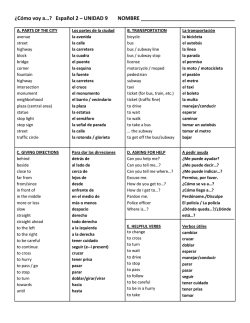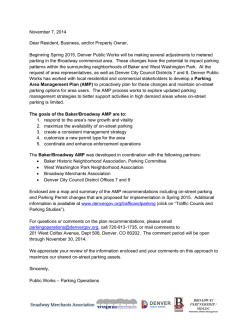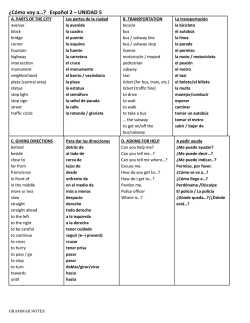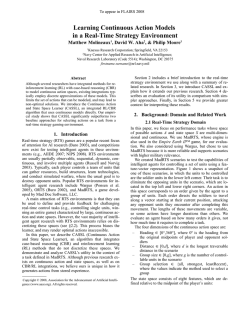
An overview of the 2015 Plan - Department for Regional Development
BELFAST METROPOLITAN TRANSPORT PLAN 3. An Overview of the 2015 Plan INTRODUCTION 3.1 Part B of this document presents the 2015 Belfast Metropolitan Transport Plan. This chapter presents an overview of the 2015 Plan as framed by the longer-term 2025 Strategy. Subsequent chapters then describe the Plan elements in more detail. 3.2 The components of the 2015 Plan and 2025 Strategy are described according to four modal themes, as follows. ♦ Provision for Walking and Cycling – such as walking corridors and cycle routes; ♦ Public Transport measures – such as bus and rail schemes; ♦ Highway measures – such as road schemes; and ♦ Management measures – such as parking controls or traffic management used to control traffic and influence travel demands and patterns. 3.3 The Plan has been developed to deliver an integrated transport network – improving opportunities for interchange between different modes of transport and providing real travel choices, particularly in the BMA’s main transport corridors. Almost all of the individual elements are complemented by other elements in delivering this integrated network and need to be seen as part of a system rather than viewed in isolation. Importantly, the elements are also integrated with the land use plan for the BMA that forms the basis of the BMAP. 3.4 Additionally, Chapter 8 presents the Plan’s proposals for each of the six council areas in the BMA, demonstrating how proposals across each of the modal themes are integrated across the BMA’s transport system. DESCRIPTION OF THE CONTENTS OF THE PLAN 3.5 The Plan is summarised by mode in Table 3.1. As discussed in Chapter 2, a 2025 Long-Term Strategy has been developed as a means of framing the medium term 2015 Plan. The table presents a summary of both the 2025 Long-Term Strategy and the 2015 Plan, providing an indication of those elements of the long-term strategy that have been identified as priorities for implementation in the period to 2015. 3.6 The table also indicates the estimated cost of implementing the 2015 Plan for each scheme proposal. 3-1 Introduction of networks to encourage and support greater levels of walking and cycling. An extensive Quality Bus Corridor (QBC) network focused upon radial MTCs, supplemented by routes serving other corridors. The QBC network to be supported by extensive bus priority measures plus increased service frequencies, improved access to bus stops and real time passenger information. Orbital QBCs supplementing the radial QBC network with new orbital routes to a similar standard of provision to the radial QBCs. Quality Bus Corridors (QBC) Orbital Bus Corridors 2025 Strategy ♦ ♦ 3-2 Inner Orbital corridor (MTC H) as an extension of the existing Centrelink services; and Outer Orbital corridor (MTC G). Introduction of new orbital bus routes to complement the radial QBC network. Routes will be subject to detailed business case review but are expected to serve: ♦ ♦ £ 9.0 Real time information costs are included in Technology (ITS) bus priority measures; service frequency improvements of up to 50% compared to existing levels; modern high quality low floor buses; improved bus stop facilities including real time passenger information plus improved access to bus stops; bus lane enforcement cameras; and QBCs implemented on 14 sets of routes in the following corridors: − Belfast-Antrim corridor (MTC A) on two routes - Antrim Rd. and using the M2 (City Express); − Belfast-Lisburn corridor (MTC B) on 3 routes - Falls Rd., Lisburn Rd and Malone Rd.; − Belfast to West and North Belfast on 3 routes - Springfield Rd., Shankill Rd. and Crumlin Rd.; − Belfast-Castlereagh Rd. corridor; − Belfast-Cregagh Rd. corridor; − Belfast-Downpatrick corridor (MTC C) on Ormeau/Saintfield Rds. – enhance existing facilities; − Belfast-Newtownards corridor (MTC D) on Upper Newtownards Rd.; − Belfast-Bangor corridor (MTC E) on Holywood/Bangor Rds.; − Belfast-Carrickfergus corridor (MTC F) on Shore Rd. ♦ ♦ ♦ ♦ establishment of a comprehensive cycle network complementing existing provision for cyclists with networks focused on the main urban centres and main transport corridors, linking public transport nodes, local trip generators and attractors in and around urban centres. ♦ £ 59.5 establishment of a quality walking network focused on each of the main urban centres and main transport corridors, linking public transport nodes, local trip generators and attractors in and around each urban centre; and ♦ £ 35.7 2015 Plan Implementation 1 Cost (£ mill) Implementation of an extensive Quality Bus Corridor (QBC) network with: improved facilities for walking and cycling as a result of traffic calming on local roads; ♦ Implementation of the following initiatives: 2015 Plan Table 3.1 – Summary of the 2025 Strategy and 2015 Plan Facilities for walking and cycling Measure Type BELFAST METROPOLITAN TRANSPORT PLAN Walking and Cycling Public Transport The expansion of Demand Responsive Transport bus services in the rural areas of the BMA. The expansion of Urban Community Transport services Bus priority measures provided on the strategic road network, in appropriate locations, to provide reduced journey times for longdistance bus/coach services and to complement park-andride proposals. Integration of taxi services with other forms of public transport Urban Community Transport Bus Priority on the Strategic Highway Network Taxi Services Improvements to service frequencies for longerdistance bus and coach services on radial routes to and from Belfast supported by improved integration with local and rural bus services and by bus priority measures on certain sections of the strategic road network. The improvement of local bus services focused on Bangor, Carrickfergus and Lisburn. 2025 Strategy Demand Responsive Rural Bus Services Other local bus services and long distance bus/coach services Measure Type BELFAST METROPOLITAN TRANSPORT PLAN Public Transport cross town/city linking services; regular interval timetables and integrated ticketing; integration with rail services; modern accessible buses; new routes to access developments; and redevelopment of Smithfield Square bus station in Lisburn and enhancement of Joymount bus stands in Carrickfergus. ♦ ♦ ♦ ♦ ♦ ♦ Provision of bus priority as part of the roll-out of the QBC network will also assist taxis. ♦ 3-3 Provision of improved facilities for taxis at major bus and rail stations in the BMA; and ♦ Implementation of bus priority measures on the M2 in the Antrim Corridor (MTC A) between Fortwilliam and York Street and on the Sandyknowes on-slip southbound to supplement that already on the M1 in the Lisburn Corridor (MTC B) between Stockman’s Lane and Broadway junctions. Improvements to make transport more accessible to people unable to use conventional public transport services, including those with disabilities. Demand Responsive Transport – including variable route and dial-a-ride services, both integrated with conventional fixed route bus services and community transport services. increased service frequencies on core routes; ♦ Incremental roll-out of measures and improvements to include: 2015 Plan £0.4 £ 1.1 £7.1 £2.5 £ 5.9 2015 Plan Implementation 1 Cost (£ mill) Maximise the value of the investment in the rail network by increasing catchment areas and by supporting development and regeneration proposals through the provision of new stations and improving interchange facilities. Improve service frequencies on all routes in the BMA. Rail service frequency and service pattern changes A rapid transit network comprising routes in each of the radial MTCs. All routes would initially be implemented as bus rapid transit, with potential migration in the longerterm towards Light Rail Transit (LRT). Rapid transit New and improved rail stations 2025 Strategy Measure Type BELFAST METROPOLITAN TRANSPORT PLAN Public Transport CITI-Route rapid transit serving Belfast City Airport and the Titanic Quarter of the Harbour Estate in the Bangor Corridor (MTC E); and SuperRoute in the Downpatrick corridor to the Carryduff area (MTC C). ♦ ♦ relocation of Jordanstown station in the Carrickfergus Corridor (MTC F); a new station at Tillysburn to serve Belfast City Airport (MTC E); measures to improve access to other stations in the BMA; and retention of options to provide new and improved rail stations and major public transport interchanges within Belfast city centre as part of the potential redevelopment of sites at Great Victoria Street and Gamble Street. These schemes are subject to developer contributions and their implementation is expected to be outside the 2015 Plan period. ♦ ♦ ♦ ♦ 3-4 Increase in service frequencies up to 50% with additional trains focused on providing more express services. a new station at West Lisburn (MTC B); ♦ New or re-located rail stations provided as follows: The extent of development of the rapid transit network will be reviewed following implementation of the EWAY scheme. (Final decisions on all aspects of the proposed rapid transit network will be subject to detailed economic appraisal, budgetary processes and the completion of statutory processes). It is envisaged that EWAY will be advanced as a private finance initiative. WWAY from Belfast City Centre into West Belfast; ♦ Detailed planning of rapid transit schemes in three other corridors not served by rail infrastructure and/or to support major development proposals, as follows: The commencement of a bus rapid transit network with the implementation of an EWAY scheme in the Newtownards corridor (MTC D). 2015 Plan £ 47.5 £ 13.0 Includes cost of EWAY and planning costs for other schemes £101.2 2015 Plan Implementation 1 Cost (£ mill) Strategic highway network capacity enhancements The strategic network needs to be enhanced such that it can: ♦ safely and efficiently cater for longerdistance movements to, from and between different parts of the BMA; and ♦ support the reduction of traffic and the negative impacts of traffic on the non-strategic road network with capacity enhancement schemes to address key bottlenecks and provide a consistent standard of road. Park-and-ride facilities on each radial MTC served by bus services or rapid transit and introduced in conjunction with parking restraint measures in central Belfast. Expansion of existing parkand-ride provision at rail stations. Rail-based park-and-ride Bus/rapid transit-based park-and-ride 2025 Strategy Measure Type BELFAST METROPOLITAN TRANSPORT PLAN Public Transport Highway 3-5 The following proposals have been identified as priorities for implementation within the Plan period: ♦ the widening of the M1 from Blacks Road to Broadway and grade separation of the junctions on Westlink; ♦ the widening of the M2 from 2 lanes to 3 lanes between Sandyknowes and Greencastle junction (MTC A) including the improvement of Sandyknowes junction (M2/A8); ♦ the widening of the A2 at Greenisland on the Carrickfergus corridor from one lane in each direction to two lanes in each direction (MTC F); ♦ the widening of the A2 Sydenham Bypass between Tillysburn and the M3 Lagan Crossing from a 2-lane dual carriageway to 3-lane dual carriageway (MTC E ); and ♦ the widening of the A55 Outer Ring Road at Knock Road from one lane in each direction to 2 lanes in each direction with right turning provision. The following local sites served by dedicated bus/rapid transit services have been identified for implementation within the Plan period: ♦ Fortwilliam on the Antrim and Carrickfergus Corridors (MTCs A and F); ♦ Kennedy Way on the Lisburn Corridor (MTC B); ♦ Cairnshill on the Downpatrick Corridor (MTC C); ♦ Millmount, Dundonald on the Newtownards Corridor (MTC D); and ♦ Tillysburn on the Bangor Corridor (MTC E). Other more informal sites will use existing bus services and currently locations are being investigated at: ♦ Sprucefield; ♦ Sandyknowes; and ♦ Carryduff. The following sites have been identified for provision of park-and-ride facilities: ♦ West Lisburn in conjunction with a new station, as described above (MTC B); and ♦ expansion of existing provision at Carrickfergus station and new facilities at Trooperslane halt (MTC F). Increase in parking provision at other stations by formalising existing parking arrangements along with pick up/set down areas, and providing new parking spaces where feasible. 2015 Plan £151.9 £ 27.6 Excludes the cost of providing parking at West Lisburn. This is included in “New and improved rail stations” above. £ 2.7 2015 Plan Implementation 1 Cost (£ mill) Non-strategic highway network schemes Strategic highway network capacity enhancements Measure Type ♦ ♦ ♦ provide traffic relief; support environmental improvements in the urban centres; and support developments and regeneration. Road schemes to: 2025 Strategy BELFAST METROPOLITAN TRANSPORT PLAN Highway the widening of the M1 between Blacks Road and Sprucefield (Lisburn) to dual 3 lane motorway and improving the connection between the M1 and A1; a new junction on the M2 to the north of Sandyknowes; the construction of the Blacks Road Link between Upper Malone Road and the M1 at Blacks Road, Dunmurry, with sliproads onto the motorway, to provide a strategic alternative to the existing A55; realignment of the A24 between Cairnshill and the A55 Outer Ring Road to bypass Newtownbreda; and A8 dualling and provision of Ballynure north-east link. 3-6 The implementation of the above schemes, other than those in Belfast City Centre and Dundonald, will be developer led with funding at the appropriate level. Developers will be responsible for funding the scheme either in full or in a very substantial part. The Department’s priority for funding will be concentrated on the construction of major capital works schemes on the Strategic Network. Any contribution towards developer-led schemes will be subject to detailed economic appraisal, the availability of funding and inclusion within the Major Works Programme. Other non-strategic highway network schemes in conjunction with potential development as outlined in area plans may be progressed during the Plan period. The following proposals have been identified within the Plan: 3 ♦ a new road, the M1 – Knockmore link, to the West of Lisburn ; ♦ the Connsbank Link – a new link road between the Newtownards Road/Holywood Arches and the 3 A2 including Holywood Arches bypass and a new junction with the A2 ; 3 ♦ the North Lisburn Feeder Road ; 3 ♦ Carrickfergus Spine Road including Victoria Road and Sloefield Road Schemes; 3 ♦ Ballyclare relief road ; ♦ a new road link between Quarry Corner and East Link Road in conjunction with the EWAY rapid transit scheme providing an alternative to the existing A20 through Dundonald; 3 ♦ Hightown Road Link – providing improved access to Mallusk ; and ♦ the Bankmore Link – between Dublin Road and Cromac Street in Belfast. ♦ ♦ ♦ ♦ ♦ Protection of and detailed planning for a number of other strategic network schemes is provided for in the Plan, though it is expected that the implementation of these schemes will be outside the 2015 Plan period. These schemes are as follows: 2015 Plan The cost of the Quarry Corner-East Link Road scheme is included in cost of EWAY £ 84.6 Costs not included as schemes would be implemented after 2015. 2015 Plan Implementation 1 Cost (£ mill) 2025 Strategy Traffic management measures to improve the safety and efficiency of the strategic highway network, particularly in locations where there are constraints on the delivery of significant capacity enhancement schemes such as widening or providing new roads. Application of traffic management measures to improve the flow of traffic and reduce the negative impacts of traffic on the local road network, with particular emphasis on residential areas and the main urban centres. Use to be made of Intelligent Transport System solutions to support other transport initiatives, recognising that given the rapid evolution of technology in this area, longer-term options will be kept under review. Measure Type Strategic highway network traffic management Non-strategic highway network traffic management Technology (ITS) BELFAST METROPOLITAN TRANSPORT PLAN Highway Management Route Management Strategies, supported by ITS, progressively implemented on the strategic network including minor improvement measures to improve efficiency and safety with particular focus on the A2 to Bangor, A20 Upper Newtownards Road on sections outside the Outer Ring Road, the A24 Saintfield Road on sections outside the Outer Ring Road, and the A55 Outer Ring Road. Also includes a pilot demand management scheme on Westlink. traffic management measures on local and distributor roads to improve the flow of traffic, in conjunction with improvements to the strategic road network and the implementation of significant public transport alternatives; traffic management measures in Belfast city centre comprising the reduction of existing road capacity within the core of the city centre enabling the reallocation of space to pedestrians, cyclists and public transport and supporting improvements to the city centre environment. traffic management measures in the centre of Bangor, Carrickfergus and Lisburn to improve conditions for pedestrians, cyclists and public transport and support environmental improvements; and traffic management measures on the A20 Newtownards Rd (MTC D), inside the A55 Outer Ring Road, to reduce the attractiveness of this route for use by strategic traffic and provide greater priority for local movements, walking/cycling and public transport, implemented in conjunction with the planned major public transport improvement in MTC D in the form of EWAY. ♦ ♦ ♦ ♦ ♦ ♦ ♦ ♦ ♦ 3-7 real time passenger information and Integrated ticketing system for the public transport system; implementation of travel information dissemination systems; motorway control and incident detection systems on the strategic highway network; Variable Message Signing (VMS) in conjunction with park-and-ride and parking provision; and linking of systems through Urban Traffic Management Control (UTMC). The following Intelligent Transport Systems measures expected to be implemented in support of other transport initiatives: traffic calming measures on local roads and in residential areas; ♦ The progressive implementation of: ♦ 2015 Plan £ 21.8 £ 104.0 £ 24.8 2015 Plan Implementation 1 Cost (£ mill) restricting the number of parking spaces provided at new residential developments by imposing maximum parking standards. ♦ 3-8 Not proposed for implementation, but a detailed review will be undertaken during the Plan period. Congestion Charging Implementation of a congestion charging scheme as a demand management tool that is expected to be focused on journeys made by car in peak periods. The options available for implementing congestion charging are continually evolving. restriction of the further increase in the growth in Private Non-Residential (PNR) parking – that associated with commercial premises such as offices and shops – by imposing maximum parking standards to developments that restrict the number of PNR spaces that can be provided. This would be enforced through planning agreements that restrict developers to certain design principles; and ♦ Implementation of measures to better manage parking in the other main urban centres in conjunction with traffic management measures. use of land use planning controls to: reduce the number of temporary car parks on derelict land; and to restrict the development of new private-sector public car parks; ♦ more effective enforcement and management of parking made possible by Decriminalised Parking Enforcement (DPE) which will enable responsibility for parking enforcement to be passed from the Police Service of Northern Ireland (PSNI) to DRD. ♦ reduction in the number of public off-street parking spaces provided for long-stay (i.e. commuter use) by turning over car parks to other forms of use and by setting charge structures that discourage long-stay use; conversion of all uncontrolled on-street parking spaces to controlled spaces in a defined Controlled Parking Zone covering central Belfast and its immediate walk-in catchment area; ♦ ♦ modification of existing parking restrictions for on-street parking and – where appropriate – set parking charges to discourage long-stay parking and maximise the use of short stay spaces; ♦ Implementation of a parking policy focused on central Belfast comprising: 2015 Plan Schemes to provide motorists with opportunities to park their cars and share other transport to their destination. Improve parking controls in the other main urban centres to complement traffic management measures and maximise parking utilisation in a way that best supports economic vitality. Implementation of a parking policy focused on central Belfast that enables more effective parking controls to be applied and supports other demand management measures that seek to reduce peak car trips to the city centre. 2025 Strategy Park-andshare Parking Measures Measure Type BELFAST METROPOLITAN TRANSPORT PLAN Management £ 0.2 £ 0.5 £ 2.2 2015 Plan Implementation 1 Cost (£ mill) implementation of the Safer Routes to School initiative. ♦ n/a n/a n/a Bus Replacement Programme Rail Revenue Support Railways Task Force Consolidation fuel duty rebate; and other NITHC costs. ♦ ♦ Public Service Obligation; and other NITHC costs. ♦ ♦ 3-9 Includes provision for rolling stock, infrastructure and safety measures. concessionary fares; ♦ Ongoing funding for the following items: Rolling programme to provide new buses with high standards of comfort and accessibility and reduce the average age of the fleet to 8 years. concessionary fares; ♦ Ongoing funding for the following items: n/a implement a BMA-wide travel awareness campaign supplemented by localised campaigns in conjunction with the implementation of major public transport schemes; and ♦ Bus Revenue Support support and promote Travel Plans, implemented through planning agreements or conditions on planning permission; 2015 Plan ♦ Implementation of BMTP Proposals Widespread measures to influence travel attitudes and encourage greater levels of walking, cycling and use of public transport Changing Travel Attitudes Sub-Total Further review of charging options is required before firm decisions can be reached. 2025 Strategy Congestion Charging Measure Type BELFAST METROPOLITAN TRANSPORT PLAN Management Other RTS Initiatives £ 113.7 £ 166.3 £ 62.3 £ 153.6 £ 706.7 £ 3.5 2015 Plan Implementation 1 Cost (£ mill) replacement of four Castle Class trains. ♦ network management costs; and car parking maintenance ♦ ♦ Off-street parking bays to replace on-street parking removed to allow construction of bus lanes. Implementation of these schemes is dependent in whole or for the greater part on developer contribution. See paras 3.7-3.8 for explanation. 2 3 4 3-10 All costs are estimated and will be subject to further detailed review as part of the implementation of the Plan. Costs are quoted in 2001 prices and include an allowance for optimism bias – the systematic tendency to underestimate costs of infrastructure schemes. 1 Table Notes: BMTP PROPOSALS AND OTHER RTS INITIATIVES TOTAL £ 1913.2 £ 1206.5 £ 7.1 £ 5.6 £ 6.0 £ 602.9 Other RTS initiatives4 New street lighting to improve safety and upgrade old systems Improving layouts and equipment Programme to strengthen the bridge infrastructure to accommodate heavier vehicles. routine maintenance of roads and footways such as grass cutting, gully cleaning etc.; structural maintenance of surfaces and foundations; ♦ ♦ Ongoing funding for the following items: £ 22.9 £ 59.4 2015 Plan Implementation 1 Cost (£ mill) Sub-Total n/a Research, Monitoring and Review maintenance of the existing rolling stock; and ♦ Provide new trains ongoing investment in railway infrastructure including track and routine maintenance; ♦ 2015 Plan £ 6.7 n/a Street Lighting Capital Programme 2025 Strategy Funding to support ongoing research into improving the transport system and monitoring/reviewing plan implementation. n/a Car Parking Capital Programme n/a Highway Maintenance n/a n/a New Train Sets Bridge Strengthening n/a Railways Capital and Rolling Stock grants Measure Type BELFAST METROPOLITAN TRANSPORT PLAN Other RTS Initiatives BELFAST METROPOLITAN TRANSPORT PLAN IMPLEMENTATION COSTS 3.7 The RTS proposes a range of strategic transportation investment priorities for NI totalling an estimated £3.5 billion over the period to 2012. Commitments to proceed with any major capital schemes will be subject to the normal budgetary process, detailed economic appraisal and the successful conclusion of any statutory procedures. The costs of the initiatives, estimated in broad terms during the development of the RTS, will also need to be refined through the strategy implementation process. The RTS provides an important context for increasing investment in NI’s roads and public transport infrastructure. 3.8 The RTS identifies investment priorities across NI. Around £1.4 billion – approximately 40% of the NI total – could be directed at transport in the BMA over the period 2002 to 201211. Of this, a significant proportion is required for asset renewal such as the replacement of railway rolling stock, bus fleet modernisation and the maintenance of the road network. These initiatives are aimed at redressing the effect of years of under-investment in transportation. Significant funding could, though, be directed at new enhancements to transport infrastructure and services in the BMA before the end of 2012. 3.9 The 2015 BMTP extends beyond the end of the 2002-2012 RTS period. Assuming the same level of funding of transport beyond 2012 it is estimated that an additional £0.5 billion could be directed at transport between 2012 and 2015. This would bring total transport funding for the BMA over the Plan period to around £1.9 billion. 3.10 To aid the development of the Plan, the RTS funding levels extrapolated to 2015 have been used as a means of assessing the affordability of the BMTP proposals. Table 3.2 presents a comparison of the estimated cost of implementing the Plan against the broad level of funding that could be needed up to 2015. Table 3.2 – Comparison of 2015 BMTP Implementation Costs and Indicative Funding from RTS (£ million) Estimated BMTP Implementation Costs12 Funding to 2015 Projected from RTS Walking/Cycling13 £118m £53m Bus and rapid transit £437m £542m Rail £429m £451m Highway £922m £863m £7m £7m £1913m £1916m RTS Measure Type Research, Monitoring and Review Total 11 It is noted that the RTS employed a slightly different definition of the BMA than that required to be used by BMTP to ensure consistency with BMAP. In addition the RTS separately identifies the Regional Strategic Transport Network (RSTN), rural areas and other urban areas, some of which fall within the BMA and are included within the BMA for the purpose of developing the BMTP. The £1.4 billion is adjusted to resolve these anomalies. 12 Costs are in 2001 prices. 13 Walking/Cycling cost includes expenditure on traffic calming schemes. 20% of the BMTP Walking Strategy cost and 5% of the BMTP Cycling Strategy cost have been reallocated to Bus and Rail on the basis that this money would be spent on improved access to bus stops and rail stations. 3-11 BELFAST METROPOLITAN TRANSPORT PLAN 3.11 This indicates that the 2015 Plan is compatible with the level of funding identified by the RTS. However, it needs to be recognised that the actual level of finance available for transport investment over the next 10-15 years is not known in detail and will be subject to the normal budgetary processes. Relative Funding by Mode 3.12 The RTS also identifies the relative funding by transportation mode. Figure 3.1 shows the RTS funding proposals for transport initiatives within the BMA, identifying the proportion of the RTS funding assumed directed at the BMA by transport mode. 3.13 The balance of spend between modes shown in Figure 3.1 has been used as means of assessing the degree of consistency of the BMTP proposals with the RTS. Figure 3.1 – Estimated Relative Funding by Mode14 Relative RTS Funding for the BMA Relative BMTP Funding Requirement 3% Walk/cycle 6% Bus Rail Highway 28% 45% 23% 48% 23% 24% 3.14 Figure 3.1 shows that the balance of spend for the BMTP proposals is broadly consistent with the RTS. BMTP plans to spend a greater proportion on walking and cycling schemes, with proportionately less being spent on bus/rapid transit. If the proposed EWAY scheme proceeds it will be reviewed and, subject to the result of the review, additional funding may be required for future development of the rapid transit network. 14 Relative RTS funding based on funding identified in the RTS for the BMA to 2011/12. Relative BMTP Funding Requirement based on estimated BMTP implementation costs to 2015. 3-12
© Copyright 2026




